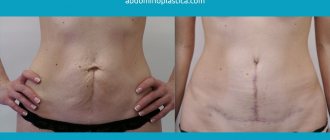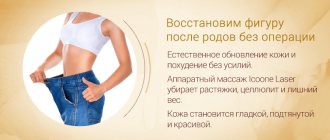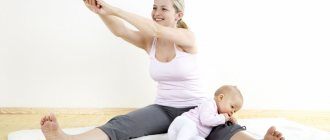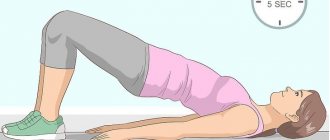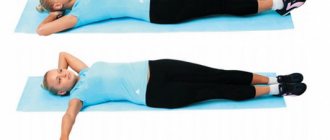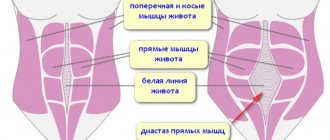Features of the female physique
Many women associate the dream of a perfectly flat stomach with total weight loss. And they even begin their path to the ideal, practicing all kinds of methods for regulating body weight. The kilograms are gradually decreasing and the weight seems to be normal, but the figure still remains imperfect - the stomach does not become flat and the waist is thin. Quite natural questions arise: what is this connected with, and how to proceed?
The fact is that even with normal weight, fat deposits can be distributed unevenly. So, some thin-looking women have a fairly significant layer of fat on the abdomen, buttocks and thighs. That is why for a good figure it is not so much the ratio of weight and height that is important, but the size of the fat layer.
The normal level for a healthy woman is considered to be 23-24% fat, with 10-12% of it accumulating in the chest, buttocks, and inner thighs (trained female athletes, as a rule, have only 10-15% fat).
It is believed that it is difficult for an adult woman to achieve a figure below 17%, moreover, reducing body fat below 13% can significantly harm health.
During pregnancy, as a result of hormonal changes in the body, the fat layer increases. It must protect the fetus from external influences. This is especially true for the abdomen, so after childbirth, in addition to stretched muscles, which should return to normal over time, there remains a layer of fat on the abdomen. Because of this, it protrudes, looks uneven and ugly.
What can be done in such a situation? It is necessary to reduce the percentage of fat, while simultaneously increasing the strength of the abdominal muscles, giving them the desired shape.
Recovery after childbirth
Within two to three days after giving birth, a woman feels a noticeable improvement in her physical condition. But full recovery will take longer. What happens in the body during this period, how does the work of organs and systems change? Let's look at this in more detail.
- Genitourinary system
Bloody vaginal discharge continues for two to three months after childbirth. In the first six weeks, a woman is most vulnerable to sexually transmitted infections, so she needs to abstain from intimate relationships.
After childbirth, the pressure of the uterus on the bladder decreases, which is why the urge to urinate becomes less frequent at the same rate of bladder filling. To avoid cystitis and other postpartum complications of the genitourinary system, it is recommended to force yourself to go to the toilet every two to three hours.
- Endocrine system
A sharp change in hormonal balance during the recovery period often leads to postpartum depression, which can last for a long time. Taking Omega-3 polyunsaturated fatty acids during pregnancy, according to scientists, prevents the development of postpartum depression. Vitamins B, E, D also improve the condition of the nervous system and have a positive effect on the emotional state. The Pregnoton Mama complex contains all these important substances and accelerates recovery after childbirth.
- Abdominal organs
The first two to three weeks after birth, constipation may occur, the cause of which is a decrease in the pressure of the uterus on the intestines. To avoid digestive problems, you need to include “laxative” foods in your diet (for example, kefir, apples, porridge, bran). But they should also be used with caution so as not to provoke colic and bowel dysfunction in the infant.
Hemorrhoids are a condition that occurs due to damage to the hemorrhoidal veins during childbirth. Most often, over time it goes away without a trace, but there are cases when the nodes bother you for a long time. Your doctor will give you recommendations for treating hemorrhoids.
- Skin, nails and hair
Recovery after childbirth will also affect the skin, hair, and nails: their condition will gradually improve. It mainly depends on hormonal levels, but can also be associated with nutritional deficiencies in a woman's diet. Substances that are important for appearance, such as calcium, biotin, and vitamin B2, will primarily enter breast milk, since from the point of view of nature they are more important for the child. Therefore, it is advisable for a woman to take vitamin and mineral complexes after childbirth. For example, Pregnoton Mama is suitable for use during lactation and contains the most important substances - both for the child and for the mother.
Working the abdominal muscles
The shape of the abdomen depends on the thickness of the fat layer and the condition of the abdominal wall muscles. The normal condition is when the abdominal wall protrudes just a little and the stomach remains flat. Weakness of this muscle group leads to the formation of a protruding or saggy abdomen. Physical exercises to work the abdominal muscles, which are divided into four types, will help increase their tone:
- Leg work with a stationary torso - raising and lowering, bending and straightening, cross, circular movements, etc. These movements strengthen the lower abdominal muscles.
- The work of the body with motionless legs is raising, lowering, turning the body, etc. In this way, the upper abdominal muscles are strengthened.
- Simultaneous work of the torso and legs - most of the abdominal muscles are usually included in the movement.
- Cross work with the torso and legs. In this case, the oblique abdominal muscles, which form the lateral muscular walls of the abdominal cavity, receive the load.
When doing exercises, you need to remember that the abdominal muscles are attached to the lower edges of the ribs on one side, and to the pelvis on the other. Therefore, when you lift your legs, you need to lift your pelvis. When performing complexes lying on your back and raising your knees to your stomach, do not be lazy to lift your pelvis from the floor, bringing your knees closer to your forehead.
While hanging on a bar or wall bars, you also need to pull your knees to your chest, lifting your pelvis.
When can you start exercising after giving birth?
It is especially worth drawing the attention of women to the fact that you can start strengthening your abdominal muscles after a natural birth only after 6-8 weeks, after a cesarean section - after 2-2.5 months. If you put stress on the abdomen at an earlier stage, you can expect serious troubles: sutures coming apart (for example, after a cesarean section or after suturing the perineum when it ruptures), increased intra-abdominal pressure and prolapse of the vaginal walls. Therefore, do not rush into physical activity, and during the recovery period, pay attention to your diet, excluding particularly high-calorie foods. But do not follow a strict diet - this is contraindicated for a nursing mother, because a deficiency of nutrients will immediately affect the quality of milk and well-being. It is better to observe the well-known reasonable restrictions on sweets, fatty and fried foods.
Starting to breastfeed
A newborn is put to the breast for the first time in the delivery room immediately after birth. As soon as the baby is born, it is placed on the mother's stomach. While the midwife compresses and then cuts the umbilical cord, the baby actively searches for the mother's breast, crawls towards it and tries to suck. Under the influence of the baby's sucking movements, the mother's uterus begins to actively contract, which accelerates the birth of the placenta. It is very important to put the newborn to the breast immediately after birth: the first drops of colostrum contain the vitamins, antibodies and nutrients the baby needs. In addition, early feeding helps the baby survive the stress of birth.
Despite the fact that during the first 2-3 days colostrum is released from the breast in small quantities, the baby must be put to the breast from the first day (in the absence of contraindications). Colostrum is priceless in its composition, and even a few drops of it are needed by the baby.
The skin of a woman's nipples is very delicate. When breastfeeding, the nipples gradually harden, but in the first days cracks may form. To prevent this from happening, you need to put the baby to the breast for no more than 5-7 minutes in the first 2-3 days after birth, then give the other breast, also for 5-7 minutes.
There is no need to wash your breasts before each feeding (it is enough to wash them while taking a shower), because... This leads to dry skin and thus contributes to the appearance of cracked nipples.
Feeding is carried out at the first request of the newborn, without interruptions at night. The baby must be placed on an oilcloth or sterile diaper so that during feeding he does not come into contact with the mother's bed.
It is very important that during feeding both mother and baby are in comfortable positions. For the mother, this is usually in a side-lying position (especially recommended for women with stitches in the perineum) or sitting, so that the baby can be held close to the breast for a relatively long time. In a sitting position, you can place a pillow under the arm on which the newborn will lie to relieve tension from it (the arm will quickly get tired while hanging). The baby should latch onto the nipple and areola. With a correct latch on the breast, the baby's mouth is wide open, the tongue is located deep at the bottom of the mouth, the lower lip is completely inverted (it is pushed out by the front edge of the tongue lying on the lower jaw). The areola fits completely into the baby's mouth if it is small. If the areola is large, then its capture is almost complete, asymmetrical. From below, the child captures the areolas more than from above.
Exercises for a flat stomach
So, you have recovered from childbirth and are ready to develop a flat stomach. How and where is the best place to study? There are no uniform rules and recommendations for working on your own body. There are different methods from which you need to choose the one that suits you, or combine several methods at once.
Shaping
The goal of shaping is to improve your figure through exercises that borrow the best from aerobics and athletic gymnastics. Fans of such activities are often called sculptors of their bodies. This comparison accurately captures the essence of the workout - targeted impact on various muscle groups, so in addition to the abdomen, the muscles of the back, arms and legs are strengthened.
Shaping classes are held in sports clubs, where groups are recruited for classes at different times under the guidance of an instructor.
For a young mother, this option has its pros and cons. On the one hand, regular classes at the club will allow her to work on her figure at least twice a week for 40-50 minutes. On the other hand, the same lack of time and various unforeseen circumstances may prevent you from regularly attending these training sessions, so another option may be preferable for you.
Home exercise set
There are specially designed sets of simple exercises, performing which you can achieve good results, in particular, a flat stomach. At the same time, when performing any exercise, you must firmly know what, why and how to do it. Therefore, we offer some tips and recommendations:
- Before performing a set of exercises, do a short warm-up. This could be jumping rope, dancing to music, etc.
- Don't use weights. They form voluminous muscles, and voluminous abs are unlikely to be your goal.
- During exercises, keep your abs in constant tension. Pay close attention to your technique. The result will be better if you do the exercise 20 times correctly than 50 times, but carelessly.
- Train intensely. Some trainers advise sparing yourself, assuring that you can exercise half-heartedly. Of course, you can if you train for fun, but if you want to get results, you need to give it your all.
If you have never exercised before or are starting to exercise after a long break, start exercising gradually, with one approach (the recommended number of times you should do the exercise without a break), and gradually increase to four.
Watch your breath! As you exhale, tighten your abdominal muscles and pull the front wall of your abdomen into you as deeply as possible, while simultaneously relaxing your ribs so that they drop down. When you inhale, try not to relax your abdominal muscles. The abdominal wall should remain retracted. The abdomen swells mainly to the sides and upwards.
The abs should be trained at least three times a week, maximum every day.
As practice has shown, the best method of training the abs is a giant set, when several exercises are done one after another, without stopping. After each giant set, you can rest for one minute. It is recommended to perform the exercises at a fast pace and with the maximum number of repetitions. At the end of this “marathon” your abs should just be burning. But you need to approach a giant set gradually , gradually increasing the intensity of your workouts.
When performing exercises, you must constantly concentrate on your sensations, on the state of your abdomen, the muscles of which should tense.
Do not eat 1 hour before or after exercise.
Before performing the exercises, you need to stretch your muscles:
- Stretching 1. Inhale - round your stomach as much as possible. Exhale - the front wall of the abdomen moves towards the spine. Hold this position for a few seconds. Do 4-5 sets of 10 reps.
- Stretch 2: Lie on your stomach. Bend back as much as possible and fix yourself in this position for a few seconds. Do 4-5 sets of 10 times.
Now you can start the exercises.
Exercise 1
Starting position: legs together. When squatting, push your buttocks back strongly, tilt your body and place your hands on the middle of your thighs. Inhale and round your stomach, inflating it like a balloon.
Straightening up, raise your arms up and spread them in the Latin letter V. At the same time, you need to straighten your back as much as possible, exhale and draw in your stomach. This is the so-called “belly breathing.” With an exhalation, we draw in the front wall of the abdomen.
Then we inhale slowly through the nose, relaxing the diaphragm. The stomach protrudes forward. At the same time, the lower abdomen fills with air.
Exhalation - the front wall of the abdomen is drawn inward as much as possible, forcing air to exit through the nose.
When breathing with the stomach, only the lower part of the lungs is filled with air and the stomach performs a wave-like movement. The chest remains motionless. Perform 16 times.
Attention! Don't lift your heels off the floor and be sure to watch your breathing!
When performing this exercise, you need to feel the movement of the front wall of the abdomen towards the spine when breathing, which is the main point of this exercise.
Exercise 2
Starting position: lying on your back, hands clasped behind your head.
As you exhale, raise your shoulder blades and bend your legs, pull your knees to your chest and your heels to your buttocks. Be sure to suck in your stomach.
Then, spread your legs - straighten the left one, but leave it hanging, and pull the knee of the right leg towards the opposite elbow. When changing legs in a semicircle, take a short breath, but again, concentrate on exhaling and touching your elbow to your knee.
The exercise is performed as long as there is enough strength.
Exercise 3
Starting position: lie on your side, legs slightly bent. Place your shoulder on the floor slightly in front of you.
If you are lying on your left side, slightly “twist” your body around its own axis to the right. On the count of “one”, stretch your hands to your heels, while tearing off your knees and shoulder blades. Hold the pose for 30 seconds to a minute.
Next, stretch the obliques, which form the sides of your abdominal cavity, by throwing your knees to one side and your arms to the other, thus twisting your torso in the opposite direction.
Repeat the entire sequence of exercises in the starting position lying on your right side.
Exercise 4
Starting position: lying on your back, legs slightly bent and shoulder-width apart. Hands along the body, lower back pressed to the floor.
As you exhale, pull your stomach in as much as possible and lift your pelvis as much as possible towards the ceiling. Having reached the highest point, hold the pose for 30 seconds.
Engage your oblique muscles by straightening one leg and then the other for 15 seconds.
When performing these movements, try to eliminate the work of the buttocks as much as possible.
Exercise 5
Starting position: lie on your back, pull your knees to your chest. Spread your arms to the side, pressing your palms to the floor.
On the count of “one,” lift your buttocks slightly and move your hips to the side, keeping your knees together. Don't put your knees on the floor! Breathe evenly and do not lift your shoulders off the floor.
Return to the starting position and repeat the exercise in the other direction.
Exercise 6
Starting position: lying on your back, hands behind your head, legs bent, feet on the floor.
Stretch your arms forward, lift your shoulders off the floor. Inhale while lying down, exhale while sitting. You can make this exercise more difficult by holding this position.
The main mistake with this exercise is tensing your neck muscles instead of your abdominal muscles, so try not to move your head back and forth.
Exercise 7
Starting position: lying on your back, arms along your body, legs raised and bent at the knees (or straightened up, as a more difficult option).
Raise your pelvis as if you were going to do a shoulder stand, but not too high. Your hands remain on the floor, but you need to lean on them as little as possible.
The main mistake is swinging your legs to create momentum. It is necessary to lift the pelvis only using the abdominal muscles.
Exercise 8
Performed on a bed or bench.
Starting position: sit on the edge of the bed, then lie on your back, hands behind your head. Pull your legs bent at the knees towards your stomach.
Then straighten your legs so that your body is stretched into a string. Then pull your legs back up. The knees can be spread apart.
This exercise works the lower abs well.
Postpartum depression, psychological problems with sex after childbirth
The birth of a child can be a test for the psychological foundation of the individual. Sometimes this bright event raises long-hidden problems from the subconscious and opens old psychological wounds. This situation is not normal, and it will not go away on its own. In order to experience only the joy of motherhood, both the young mother and family members must be sensitive to any breakdowns and “withdrawals,” and, without attributing them to fatigue, visit a psychotherapist in a timely manner.
Libido restoration also does not occur immediately. But if suddenly his return is delayed, you should not hesitate to contact a psychologist or sexologist - the sooner, the faster sensuality and passion will return to the relationship.
What will happen if you do not eliminate:
- Lack of attention to the child
- Aversion to sex, frigidity
- Discord in the family
- Female alcoholism
- In severe cases, aggression towards the child, suicide
Solution:
Individual consultations with an experienced family psychotherapist.
Detox programs will help bring biochemical processes in the brain and throughout the body back to normal, which makes psychological work especially effective.
General health improvement of the body according to an individual plan, including relaxation, singing bowl therapy, biostimulation, thalassotherapy, massage.
Invisible training
In addition to the listed methods of actively fighting for a flat shape of your own stomach, do not forget about it in the everyday hustle and bustle, on vacation, where you can also unnoticed by others, but very effectively, once again train your abdominal muscles.
- For example, when standing in public transport, in line, or walking with your child, do not forget to regularly do invisible abdominal exercises - to draw in and relax the anterior abdominal wall. Relax as you inhale, and draw in as you exhale, trying not to hold your breath.
- When taking a shower, rub your stomach with cold water every day using a removable shower head - from the right side (at waist level) to the left and vice versa. Then use circular movements clockwise.
- When swimming in the sea, river, lake or swimming pool, take a few minutes to massage your stomach with the movement of water. To do this, clasp your palms horizontally and move them down and up at a distance of about 3-4 cm from the stomach. At the same time, you should feel how something like a strong wave touches your stomach. You need to do this exercise for as long as possible until your arms get tired.
- In the pool, holding the side with your hands and leaning your straight back against the wall of the pool, alternately lift one or the other leg to your chest, bending your knee, and then straighten it sharply to the end.
Try to live with a retracted stomach. At first, this condition will need to be constantly monitored, but then it will turn into a habit.
First hours
After spontaneous birth through the birth canal, the postpartum woman spends the first 2 hours in the maternity ward under the careful supervision of medical personnel. This is due to the fact that in the early postpartum period there is a high probability of various complications (bleeding, increased blood pressure, etc.). The postpartum woman is placed on a heating pad with ice on the lower abdomen for better contraction of the uterus. Periodically, the doctor on duty and the midwife approach the woman, ask about her general health, the presence of complaints, measure blood pressure, pulse, check the nature and amount of discharge from the genital tract, and also massage the uterus through the anterior abdominal wall.
After 2 hours, the postpartum woman and her newborn, if there are no abnormalities during the early postpartum period, are transferred on a gurney to the postpartum ward. Before transfer, the woman’s well-being and condition are checked again, body temperature and blood pressure are measured.
In the postpartum department, the postpartum woman is received by the midwife on duty, who once again checks the woman’s condition, measures her pulse, blood pressure, determines the condition of the skin and mucous membranes, the height of the uterine fundus, the soreness of the uterus and the nature of discharge from the genital tract. Then the postpartum woman is placed in the ward. After transfer to the postpartum ward, the young mother is recommended to lie on her stomach for 2 hours - this will help the postpartum discharge from the uterus to drain better and the uterus to contract.
Now in many maternity hospitals, the mother and child are encouraged to stay together in the postpartum ward, therefore, if the condition of both is satisfactory and there are no contraindications on the part of the newborn, after he is received and examined by the children's sister, the baby is immediately placed in the same ward with the mother. In some maternity hospitals, the baby is first placed in the children's ward for several hours, after which he is brought to his mother if both are in satisfactory health.
When will the results be noticeable?
If you follow the recommendations, after 1.5-2 months the abdominal muscles will become stronger and will be able to support the abdominal wall well. Working on the abdominal muscles, in addition to a flat stomach, will also provide you with an elegant thin waist, for which the same muscles are largely responsible.
But this does not mean that we can now forget about them. Only regular maintenance exercises will help maintain and improve the results obtained. Remember that a flat stomach is a lifestyle, not a one-time promotion that will provide you with it for life.
Sources
- Dijxhoorn AQ., Brom L., van der Linden YM., Leget C., Raijmakers NJ. Healthcare professionals' work-related stress in palliative care: a cross-sectional survey. // J Pain Symptom Manage - 2021 - Vol - NNULL - p.; PMID:33864848
- Silva LFD., Cursino EG., Brandão EDS., Góes FGB., Depiant JRB., Silva LJD., Aguiar RCB. The therapeutic itinerary of health workers diagnosed with COVID-19. // Rev Lat Am Enfermagem - 2021 - Vol29 - NNULL - p.e3413; PMID:33852685
- Reid A., Rhonda-Perez E., Schenker MB. Migrant workers, essential work, and COVID-19. // Am J Ind Med - 2021 - Vol64 - N2 - p.73-77; PMID:33355943
- Schwarz B., Stegmann R., Wegewitz U. . // Rehabilitation (Stuttg) - 2021 - Vol59 - N5 - p.263-272; PMID:32871608
- Cedrone F., Santangelo OE., Provenzano S., Alagna E., Dellagiacoma G., D'ambrosio A., Voglino G., Gianfredi V. Attitude of students of health professions towards a health care workers' mandatory vaccination: a multi -center cross-sectional survey. // G Ital Med Lav Ergon - 2021 - Vol42 - N2 - p.87-93; PMID:32614538
- Meesters Y., Horwitz EH., van Velzen CJM. . // Tijdschr Psychiatr - 2021 - Vol62 - N5 - p.340-350; PMID:32484562
- Schlicker S., Baumeister H., Buntrock C., Sander L., Paganini S., Lin J., Berking M., Lehr D., Ebert DD. A Web- and Mobile-Based Intervention for Comorbid, Recurrent Depression in Patients With Chronic Back Pain on Sick Leave (Get.Back): Pilot Randomized Controlled Trial on Feasibility, User Satisfaction, and Effectiveness. // JMIR Ment Health - 2021 - Vol7 - N4 - p.e16398; PMID:32293577
- Lippke S., Schüz N., Zschucke E. Temporary Disability Pension, RTW-Intentions, and RTW-Behavior: Expectations and Experiences of Disability Pensioners over 17 Months. // Int J Environ Res Public Health - 2021 - Vol17 - N1 - p.; PMID:31905698
- Zechmeister-Koss I., Tüchler H., Goodyear M., Lund IO., Paul JL. Reaching families where a parent has a mental disorder: Using big data to plan early interventions. // Neuropsychiatr - 2021 - Vol34 - N2 - p.39-47; PMID:31741296
- Adamsson A., Bernhardsson S. Symptoms that may be stress-related and lead to exhaustion disorder: a retrospective medical chart review in Swedish primary care. // BMC Fam Pract - 2018 - Vol19 - N1 - p.172; PMID:30376811

